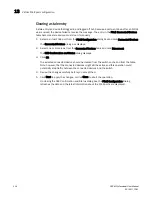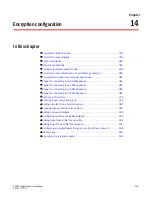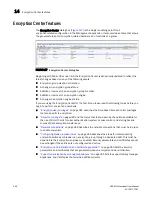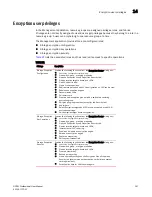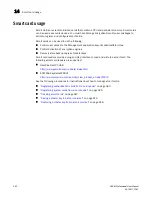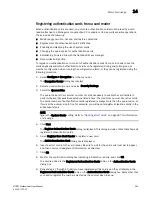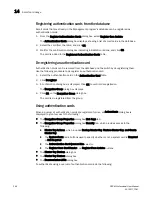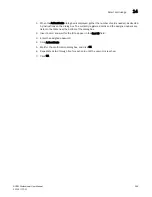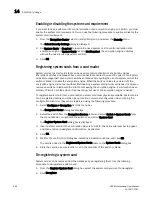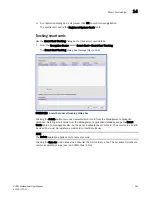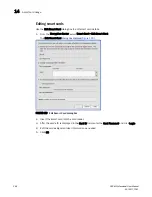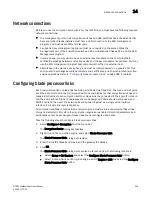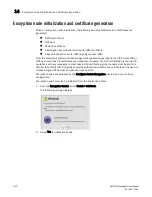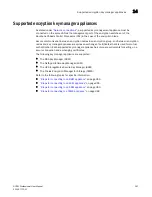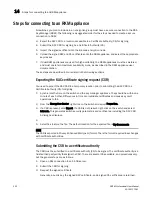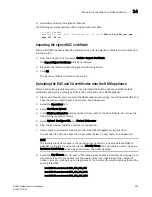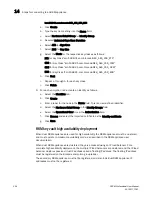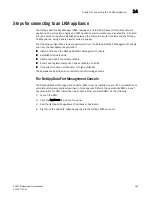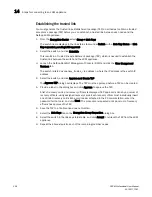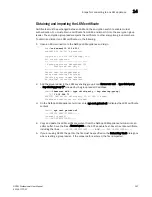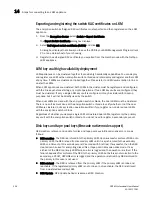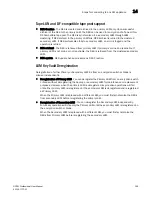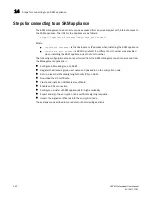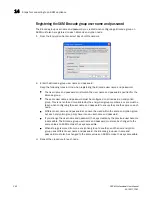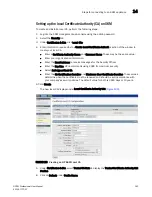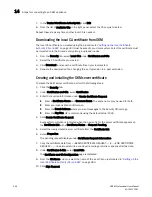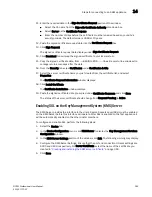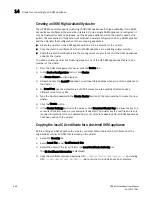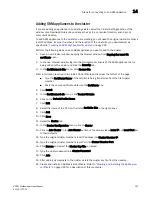
352
DCFM Professional User Manual
53-1001773-01
Steps for connecting to an RKM appliance
14
Steps for connecting to an RKM appliance
All switches you plan to include in an encryption group must have a secure connection to the RSA
Key Manager (RKM). The following is a suggested order for the steps needed to create a secure
connection to RKM:
3. Export the KAC CSR to a location accessible to a Certificate Authority (CA) for signing.
4. Submit the KAC CSR for signing be a Certificate Authority (CA).
5. Import the signed certificate into the Brocade encryption node.
6. Upload the signed KAC and CA certificates onto the RKM appliance, and select the appropriate
key classes.
7. If dual RKM appliances are used for high availability, the RKM appliances must be clustered,
and must operate in maximum availability mode, as described in the RKM appliance user
documentation.
These steps are described in more detail in the following sections.
Exporting the KAC certificate signing request (CSR)
You need to export the KAC CSR to a temporary location prior to submitting the KAC CSR to a
Certificate Authority (CA) for signing.
1. Synchronize the time on the switch and the key manager appliance. They should be within one
minute of each other. Differences in time can invalidate certificates and cause key vault
operations to fail.
2. From the Encryption Center, right-click on the switch and select Properties.
3. If a CSR is present, click Export. If a CSR is not present, right-click on the switch and select
Initnode. This generates switch security parameters and certificates, including the KAC CSR.
A dialog box displays.
4.
5. Select Yes to store the file. The default location for the exported file is My Documents.
NOTE
The CSR is exported in Privacy Enhanced Mail (.pem) format. The is the format required in exchanges
with certificate authorities.
Submitting the CSR to a certificate authority
The CSR must be submitted to a certificate authority (CA) to be signed. The certificate authority is a
trusted third party entity that signs the CSR. There are several CAs available, and procedures vary,
but the general steps are as follows.
1. Open an SSL connection to an X.509 server.
2. Submit the CSR for signing.
3. Request the signed certificate.
Generally, a public key, the signed KAC certificate, and a signed CA certificate are returned.
Содержание Brocade BladeSystem 4/12
Страница 1: ...53 1001773 01 14 April 2010 DCFM Professional User Manual Supporting DCFM 10 4 X ...
Страница 3: ...DCFM Professional User Manual iii 53 1001773 01 ...
Страница 4: ...iv DCFM Professional User Manual 53 1001773 01 ...
Страница 66: ...34 DCFM Professional User Manual 53 1001773 01 Accessibility features for the Management application 1 ...
Страница 88: ...56 DCFM Professional User Manual 53 1001773 01 Seed switch 2 ...
Страница 146: ...114 DCFM Professional User Manual 53 1001773 01 Customizing the main window 4 ...
Страница 152: ...120 DCFM Professional User Manual 53 1001773 01 Launching HCM Agent 5 ...
Страница 162: ...130 DCFM Professional User Manual 53 1001773 01 Upgrading HCM on the Management server 6 FIGURE 59 Summary tab ...
Страница 246: ...214 DCFM Professional User Manual 53 1001773 01 Syslog forwarding 8 ...
Страница 262: ...230 DCFM Professional User Manual 53 1001773 01 Generating zoning reports 10 ...
Страница 472: ...440 DCFM Professional User Manual 53 1001773 01 Encryption related acronyms in log messages 14 ...
Страница 662: ...630 DCFM Professional User Manual 53 1001773 01 ...

